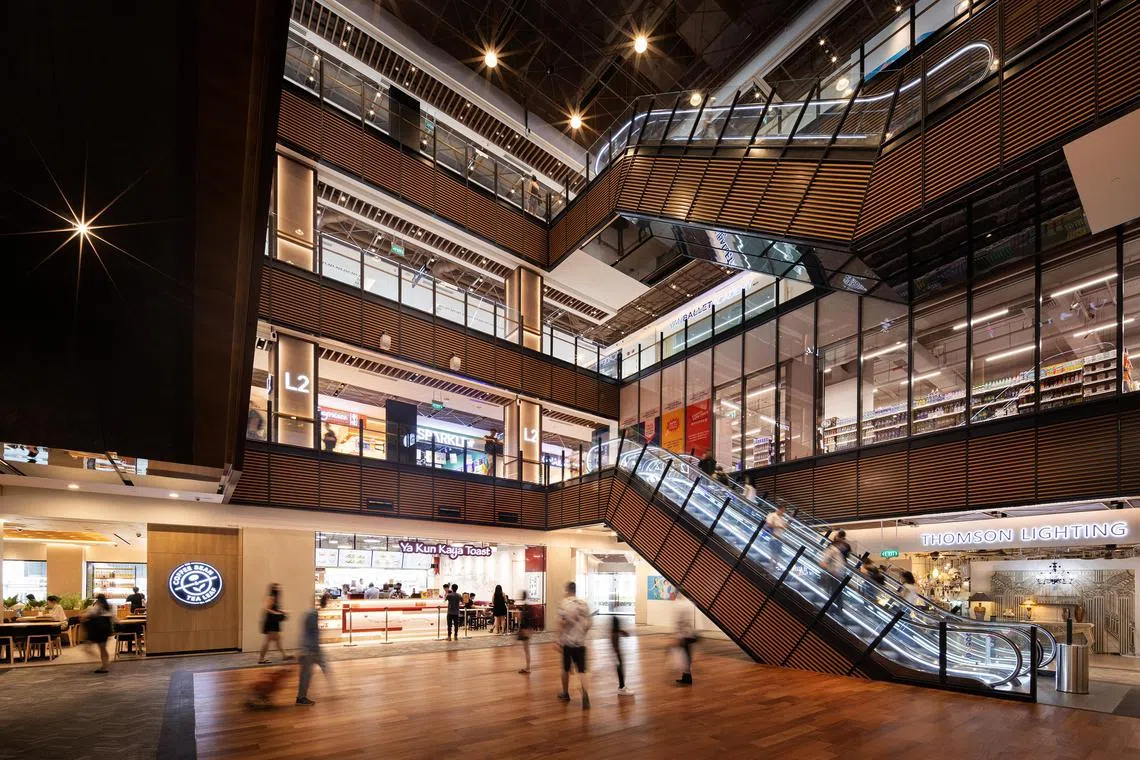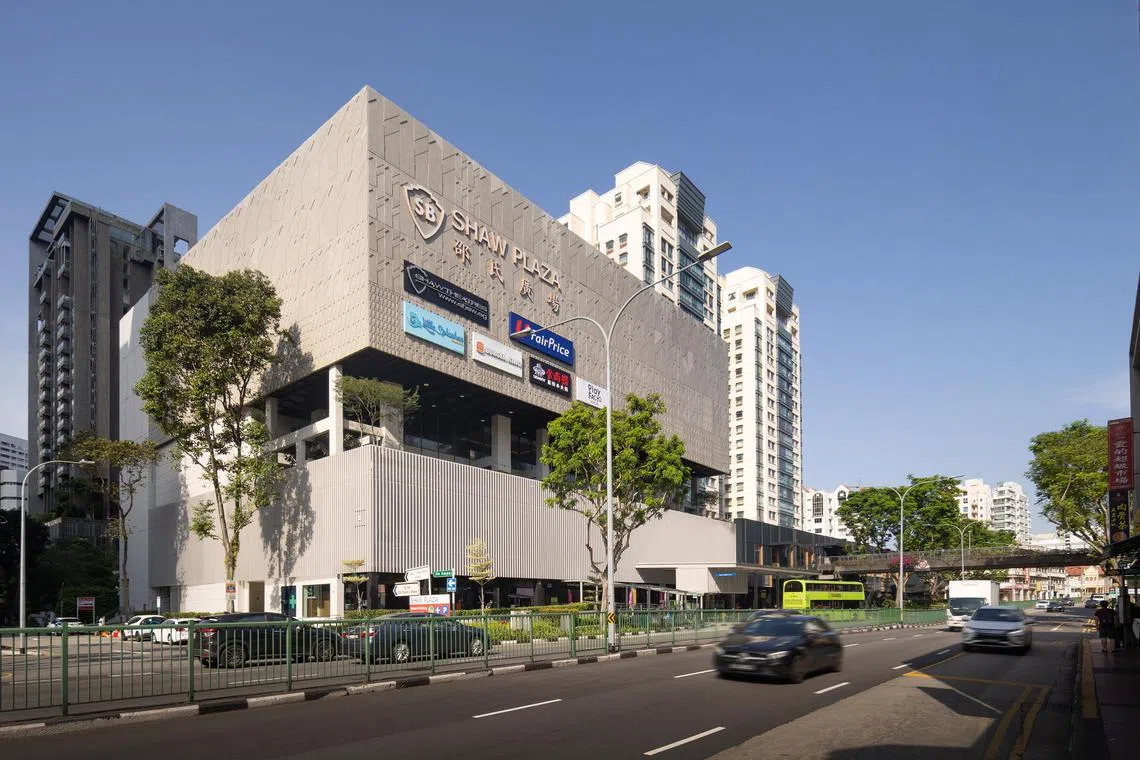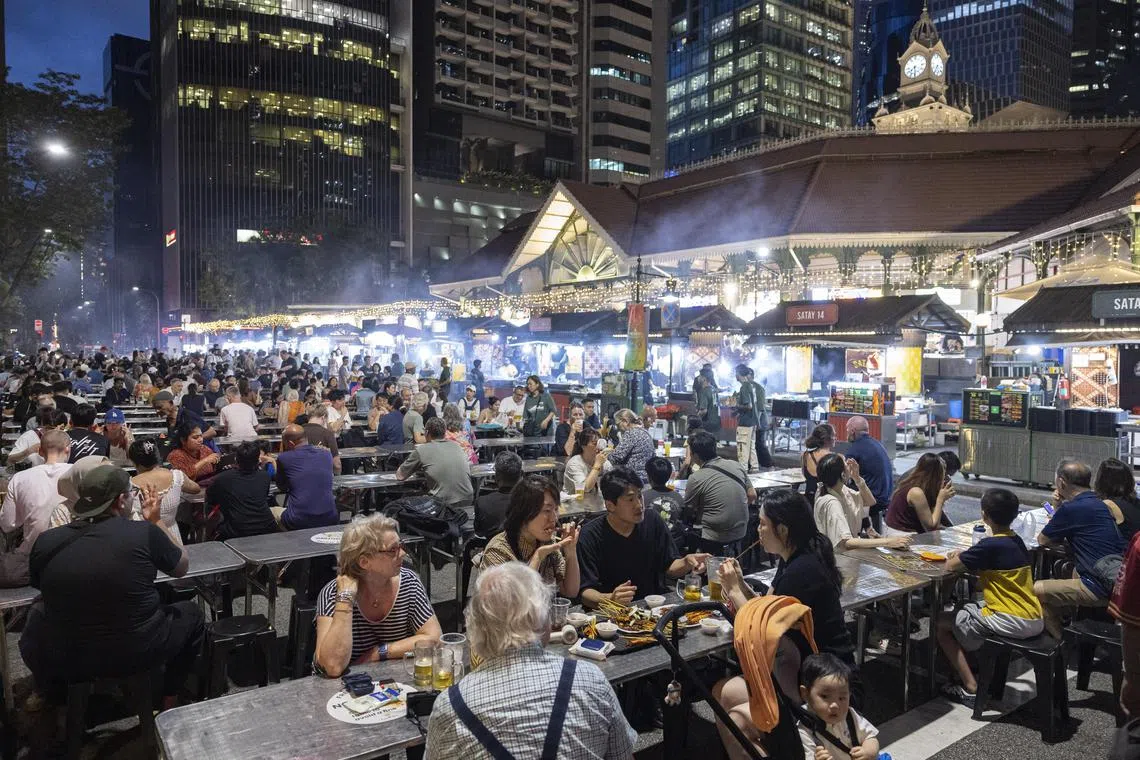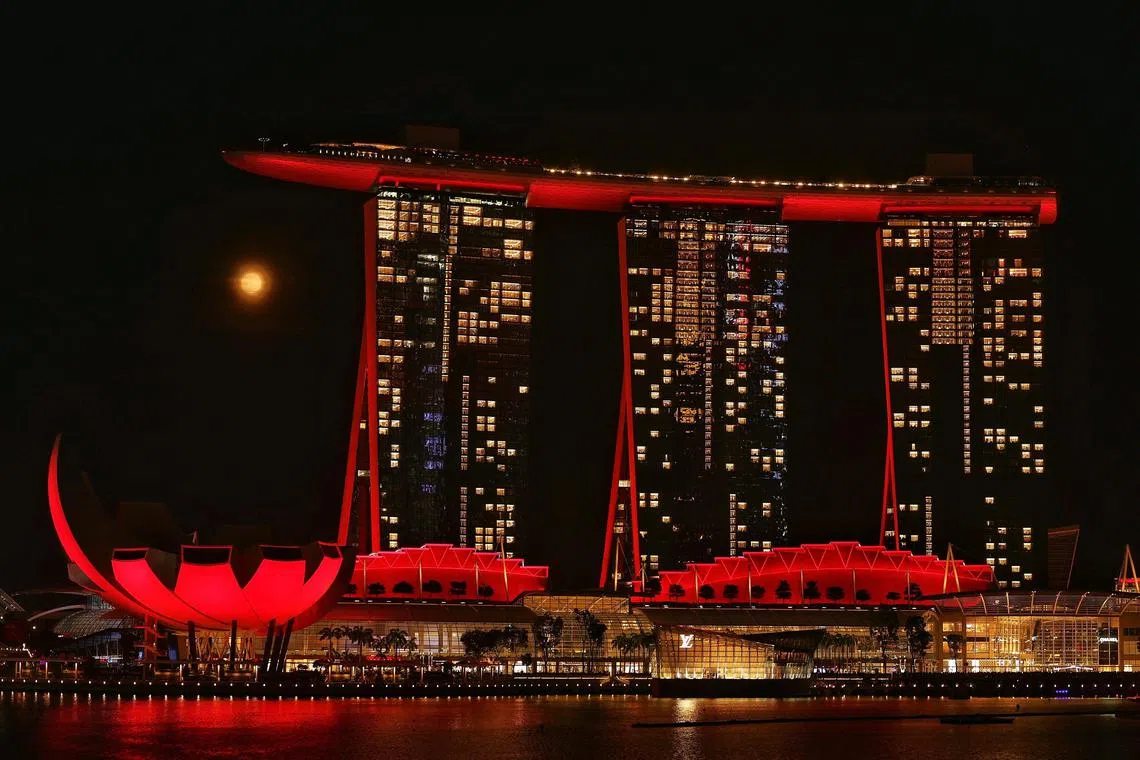Singapore ranks No. 3 in list of world’s ‘magnetic cities’
Sign up now: Get ST's newsletters delivered to your inbox

In Singapore, emotional connection is strong, with 77 per cent of residents saying they are satisfied with the city as a place to live in.
ST PHOTO: LIM YAOHUI
Follow topic:
SINGAPORE – Singapore ranks No. 3 in a new list of top 10 magnetic cities where newcomers and residents feel they are most likely to stay.
Taipei in Taiwan tops the rankings, with 64 per cent of survey respondents saying they are “unlikely” to move away from their city.
In second place is Ho Chi Minh City, Vietnam, with 61 per cent. Singapore notched 59 per cent.
The global rankings are conducted by the research unit of Gensler, the world’s largest architectural and design group.
Its Gensler City Pulse 2025 report on the Magnetic City, which attracts newcomers while retaining residents, was released in May.
It looks at urgent issues facing cities today that are locked in fierce competition, not just for investment and talent but also for the hearts of residents.
In another section of the survey, which asks respondents how satisfied they are with their city, 94 per cent of people in Shanghai, China, gave the thumbs up with “satisfied” or “very satisfied”, topping the results on contentment.
Over in Mumbai, India, 92 per cent of respondents say they are “satisfied” or “very satisfied” with life in the city.
In Singapore, the figure is 77 per cent. This is higher than the global average of 73 per cent, during the period of the survey from July 18 to Nov 22, 2024.
The report finds that in this era of the magnetic city, success belongs to those urban centres that are designed not just for growth, but also for genuine human connection.
Gensler, which employs more than 6,000 professionals in 57 offices across 16 countries, has a diverse portfolio that includes commercial buildings, urban planning, interiors and sustainability consulting.
Its Gensler Research Institute has conducted five previous City Pulse yearly surveys, since the beginning of Covid-19 in 2020.
The inaugural City Pulse study was launched in the early weeks of the pandemic to understand how lockdowns and social distancing impacted urban life.
In the subsequent years, its research looked into how cities slowly recovered from the health crisis of a generation in 2020 to greater urban mobility in 2022 and the renewed appeal of urban density in thriving cities in 2024.
Gensler points out that, as with any global study, there are limitations. The City Pulse 2025 team accounted for nuances in the collection of data.
For instance, cities in the United Arab Emirates, Saudi Arabia and China were excluded from certain rankings due to unique patterns of temporary labour and restricted internal movement, which make them global outliers.
Forces of attraction and retention
The report distils insights from more than 33,000 urban dwellers across 65 cities in online surveys that went out in 2024.
The survey’s key findings reveal that the forces that attract people to cities are not the same as those that persuade them to stay.
While economic upside, safety of residents and accessible healthcare may lay the foundation for a city’s magnetism, the intangible threads of pride, belonging and community spirit are what engender a sense of belonging to a place – transforming a city from a destination into a home.
Currently, one in three city residents around the world is considering leaving his or her home, a figure that reflects the volatility of urban populations and the high stakes for city leaders.
Another deal-breaker for global residents: over-populated cities.
According to the United Nations (UN), two out of every three people are likely to be living in cities or other urban centres by 2050, highlighting the need for more sustainable urban planning and public services.
That works out to around 2.5 billion people added to urban areas by the middle of the century, predicts the UN Department of Economic and Social Affairs in its 2018 Revision of World Urbanization Prospects.
Most of the increase is expected to be concentrated in just a handful of countries, such as India, China and Nigeria.
It also estimates that by 2030, the world may have 43 so-called megacities, up from the current 31 today.
By 2028, India’s New Delhi is projected to become the most populous city on the planet. That title currently belongs to Tokyo, with 37 million inhabitants, followed by New Delhi (34.7 million), and Shanghai (30 million), according to global demographics website World Population Review.
The UN report says that as the population in cities grows, there will be challenges in housing, transport, energy systems, employment and basic services such as education and healthcare.
Sense of belonging
Gensler’s latest study finds that retention rates soar in areas where people report a strong sense of belonging and civic pride.
Smaller cities such as Tampa and Raleigh in the United States are increasingly drawing new arrivals with a potent mix of affordability, identity and quality of life, challenging the dominance of entrenched megacities such as New York and Los Angeles. In the report, the contrast between smaller and larger cities is more discernible in the US.
In the last few years, the Global South has emerged as a focal point for new urban experiences, with cities in Latin America, Africa and the Asia-Pacific offering more opportunities.
So, what can urban planners and architects do to make cities more magnetic?
Ms Angela Spathonis, managing director of Gensler Singapore, located at Park Regis in Merchant Road, says the survey makes one thing clear: People do not stay in cities because of convenience or efficiency, but because they feel a deep emotional connection to them.
For Singapore, she says this connection is already strong, with 77 per cent of residents saying they are satisfied with the city as a place to live in.
Singapore also ranks among the top three cities globally for staying power. The report covers a range of metrics that capture both the tangible and intangible factors shaping urban experience and decision-making. These include urban experience, satisfaction, migration and demographics.
“To continue nurturing this sense of belonging, Singapore can build on what it already does well: safe neighbourhoods to walk around in, reliable infrastructure and inclusive public services,” says Ms Spathonis, 47.
“But the next step is to invest in what we call ‘emotional infrastructure’, which are places that do more than serve a function. These are spaces that help people feel connected, tell shared stories, and create a sense of identity and community,” adds the Australian.
“This means designing places that reflect who we are. From updated hawker centres and neighbourhood parks to larger civic and cultural spaces, the goal is to create environments that bring people together and grow with the community.”

Gensler Singapore worked on the interior of Shaw Plaza in Balestier. The landmark, which served the neighbourhood for decades, has been given a new lease of life with updated shops, cinemas and family-friendly spaces.
PHOTO: GENSLER
Ms Spathonis notes that as Singapore becomes more diverse and space becomes more limited, it is crucial that new developments do not just meet physical needs but also reflect the unique identity of each neighbourhood.
“When people see their culture and stories reflected in the spaces around them, they feel a deeper connection to the city,” she says.
“That’s why emotional connection is just as important as physical infrastructure. And that is Singapore’s biggest opportunity – to keep building a future-ready city that people are proud to live in, and choose to stay in for the long haul.”
‘Certainty in an uncertain world’
While emotional connection is key to long-term attachment, the latest Gensler City Pulse survey also highlights that people are initially drawn to cities that meet essential needs such as affordability, safety and access to healthcare, says Mr Najeeb Rahmat, Gensler Singapore’s co-studio director.
“Across South-east Asia, cities are rapidly evolving, leveraging infrastructure and cultural investments to enhance these factors and attract talent. Singapore’s edge, or its ‘X’ factor, lies in something even more compelling: certainty in an uncertain world,” says Mr Najeeb, 42, a Singaporean registered architect.
“What sets Singapore apart is its clear sense of direction. Whether through forward-thinking education, resilient digital infrastructure or strong institutional trust, the city offers a rare blend of innovation and stability. In a global environment marked by unpredictability, this consistency is a powerful differentiator.”
For those deciding where to build their lives, this matters deeply, he believes.
Singapore’s ability to provide a future-ready ecosystem continues to make it a compelling destination. Mr Najeeb says it is not just about attracting people. It is also about creating a place where they can envision building a future, raising families and pursuing careers.
“Cities must offer more than just amenities. They need to signal long-term reliability and a clear sense of purpose,” he adds.
“Singapore already does this well, and its continued success will depend on how effectively it shapes environments that are both liveable today and inspiring for future generations.”
Intangible values
Associate Professor Zdravko Trivic of the National University of Singapore’s Department of Architecture, College of Design and Engineering, says that while the report can be seen as one of many global studies that assess and rank countries or cities based on a range of performance indicators, it is not possible to make the specific methodologies and instruments used in the rankings clear.
As in all surveys, even with extensive datasets, findings may carry limitations or inherent biases.
Nevertheless, Prof Trivic says these assessments can offer valuable insights, revealing meaningful patterns and drawing attention to the importance of various aspects of urban environments and urban living.
He says that what sets City Pulse 2025 apart is its seemingly more holistic and inclusive evaluation framework, which gives weight to both tangible and intangible urban qualities; and an explicit recognition and strong advocacy for intangible values such as place attachment, civic pride and age-friendliness.
“While population mobility brings diversity and new perspectives, it is essential to ensure that cities continue to resonate with long-term residents. Collective efforts in cultivating and reinforcing these intangible values are key to sustaining cities as inclusive, meaningful, lovable and resilient places to live in,” says Prof Trivic.
The findings of the City Pulse 2025 study suggest that Singapore performs strongly in intangible dimensions such as peace and stability, safety and economic strength.
This aligns with the city-state’s historical emphasis on physical infrastructure and systems, or “hardware”, with a more strategic focus on “heartware” and community building that has emerged more strongly in recent decades.

Shaw Plaza in Balestier, which served the neighbourhood for decades, had a facelift and reopened in 2023.
PHOTO: GENSLER
A range of initiatives reflects this shift. Ageing-friendly design strategies, HDB town planning guides, distinctive city guidelines, cultural development plans and community participation frameworks are all part of ongoing efforts to strengthen neighbourhoods, foster a sense of belonging, and enhance overall well-being and quality of life.
But there is still more to be done, Prof Trivic says.
“As we increasingly find meaning and delight beyond the fulfilment of basic needs and convenience, greater attention must be paid to place attachment and evolving community values, especially as our built environments themselves age.”
In cases of housing displacement such as the Selective En bloc Redevelopment Scheme (Sers), nearby relocation within the community or providing familiar amenities may not be enough.
He says efforts must also focus on identifying and nurturing the “social hearts” of neighbourhoods, building emotional resilience and capacities to negotiate familiarity, continuity and community ties.
“This calls for a deeper, more empathetic approach to place-making, one that moves beyond cosmetic changes and place-branding to fostering multisensory, physically and cognitively inclusive and engaging environments that are responsive to diverse needs and can build abilities, particularly among ageing populations.
“For planners and designers, a people-centric, inclusive approach is not just desirable, it is essential, as we aim to create attractive and endearing places.”
Info: For more insights into the economic, social and environmental factors behind urban migration and retention in the Gensler City Pulse 2025: The Magnetic City report, go to str.sg/ukCd
The Gensler report’s findings in a nutshell

Crowds at Lau Pa Sat hawker centre on June 13. The latest Gensler report gathered responses across 65 cities to identify how people interact with their cities, and their priorities for urban life.
ST PHOTO: BRIAN TEO
1. Life satisfaction
The latest Gensler report gathered responses across diverse locations and populations in 65 cities to identify how people interact with their cities, and their priorities for urban life. In City Pulse 2025, respondents were asked how satisfied they were with their city as a place to live in. This metric helps the research team understand urban satisfaction on a broad scale.
In Singapore, 77 per cent said they were “satisfied” with life in the city-state. The report aims to help city leaders and developers shape policies and investments that can directly enhance their city’s quality of life.

The iconic architecture of Marina Bay Sands is emblematic of Singapore. Cities with higher purchasing power tend to attract more new residents, making economics one of the most powerful drivers of urban migration.
ST PHOTO: KEVIN LIM
2. Cost of living
Affordability plays a decisive role in how urban residents choose their next city.
Gensler’s research team analysed the percentage of newcomers in each city alongside cities’ local purchasing power, a proxy for cost of living, and found a clear and positive relationship between affordability and new residents.
Cities with higher purchasing power – where salaries stretch further for goods and services – tend to attract more new residents. Economics is the most powerful driver of urban migration. For cities aiming to attract new residents, ensuring a reasonable cost of living is essential.

A Jurassic World exhibition at Gardens by the Bay, which draws residents and visitors with diverse programming. The Gensler report shows that place attachment (the connection people feel with a city) is shaped by personal experiences.
PHOTO: ST FILE
3. ‘Place attachment’ shaped by experiences, emotion
Local attractions and other landmarks such as Gardens by the Bay draw residents and visitors with varied programming.
The Gensler report shows that place attachment – the deep connection people feel towards their city – is shaped by personal experiences, social ties and a sense of belonging. It goes beyond practical considerations, such as jobs or affordability, and includes emotional bonds, identity and familiarity.
This attachment strengthens over time, influencing whether people choose to stay in their city even as conditions change.

